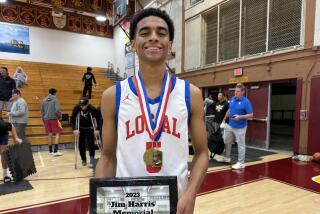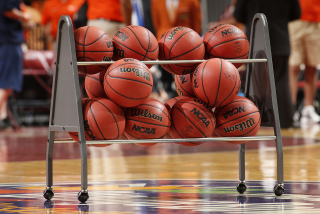DANCE REVIEW : JOFFREY BALLET TRIUMPHS IN CENTER DEBUT
- Share via
Orange County’s eagerness for culture and the Joffrey Ballet’s adventuresome spirit seem made for each other, and the audience responded enthusiastically to the youthful, all-American company when it launched its first local season Tuesday at Segerstrom Hall in Costa Mesa.
And in fact, the company looked wonderful--vibrant and whole-heartedly committed.
The program consisted of repertory staples, familiar to Los Angeles audiences but new to Orange County. Included were a landmark Vaslav Nijinsky ballet, vintage neoclassicism by Frederick Ashton, muscular modern dance by Paul Taylor, and pale neo-Romanticism by company associate director Gerald Arpino.
The high point of the evening was the revival of Nijinsky’s epic “L’Apres-Midi d’un Faune” with Tyler Walters offering a detailed, deeply felt interpretation of the Faune, and Charlene Gehm as the leader of the nymphs, conveying touching tenderness and pliancy that culminated in a melting near-surrender to the Faune.
Both dancers suffused the severely restricted movement vocabulary--faces in profile, bodies turned to the audience--with immense emotional values: Walters’ single leap evoked irrepressible exuberance; changes in their vertical relationships conveyed acknowledgment of the other’s impact, and abrupt leaning away, fear of its intensity. When they linked elbows, it became a vow made; when she slipped away, a vow not kept. Her discarded veil became a token of the pledge.
John Minor conducted the Debussy score with sensitivity. The work was reconstructed for the company in 1979 by Elizabeth Schooling and William Chappell, with the famous Bakst scenery re-created by Ralph Holmes.
Both sets of Ashton’s “Monotones” (to music by Satie) also relied upon abstract, stylized movement to refract a seemingly endless variety of intricately folded and unfolded supported arabesques and attitudes.
Unfortunately, in “Monotones I” (to “Trois Gnossiennes”), Parrish Maynard’s frequent unsteadiness in one-legged balances proved infectious to partners Dawn Caccamo and Jennifer Habig, robbing the work of its suave suppleness, although otherwise they sustained the dance impulse. In “Monotones II” (to “Trois Gymnopedies”), however, Glenn Edgerton, Elizabeth Parkinson and Tom Mossbrucker danced with utmost serenity and refinement in the fluid, lyric, lambent groupings.
Jennifer Tipton contributed the striking lighting design. Minor conducted with poise and equanimity.
In contrast to such quietude, Paul Taylor’s “Arden Court” celebrated bounding, buoyant, predominately male energy. Although Linda Bechtold, Jill Davidson and Beth Bartholomew got to participate in the joyous abandon, the bold, airy, witty, weighty and acrobatic focus belonged to the men, strongly danced by Ashley Wheater, Raymond Perrin, Douglas Martin, Carl Corry, Patrick Corbin and Peter Narbutas. Minor conducted the music by William Boyce with engaging rhythmic sense.
More aimless in its continual activity (often at variance with Verdi’s music) was the overload of Romantic ballet cliches in Arpino’s “Birthday Variations”--the dreamy poet, swooning ladies, ethereal balances and delicate pointe work.
Caccamo and Edgerton danced their central pas de deux with insouciance, but fiercely sharp port de bras and some hard-edged sophistication canceled out the yielding quality of deep backbends, soaring lifts and precarious balances. But the string of solo variations--each emphasizing different aspects of ballet technique--were danced with polish and security by Cameron Basden, Jodie Gates, Victoria Pasquale and Tina LeBlanc. Allan Lewis conducted with sprightly tempos.
More to Read
The biggest entertainment stories
Get our big stories about Hollywood, film, television, music, arts, culture and more right in your inbox as soon as they publish.
You may occasionally receive promotional content from the Los Angeles Times.










